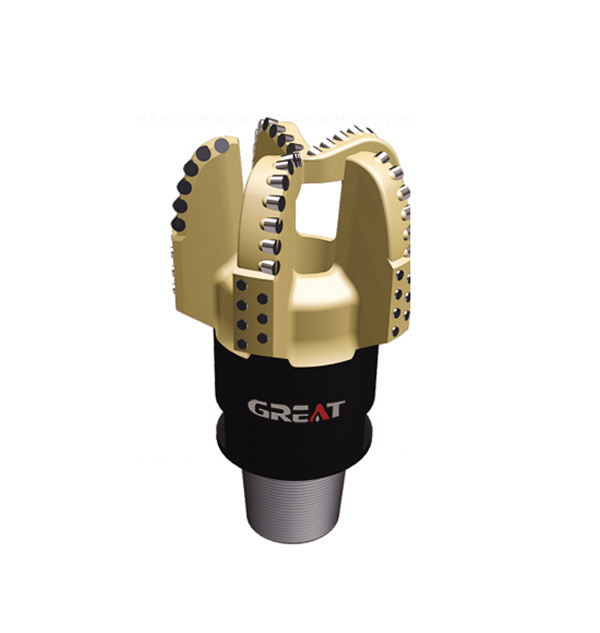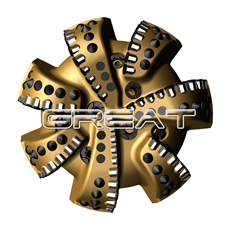Horizontal directional drilling for pipe installation is currently the mainstream method in trenchless pipe installation technology. This process typically involves three stages: the first stage is pilot hole construction, the second stage is primary or multi-stage reaming, and the third stage is pulling the finished pipe. It can be said that after completing the pilot hole, reaming is a critical and most labor-intensive operation. Hole reamers are essential tools for this purpose, and the key to successful reaming is selecting efficient and safe hole reamers based on actual conditions.
Development of Toothed Rock Reamer hole openers
Select the toothed wheels from petroleum drilling three-cone bits as cutting edges for cutting through rocks. Consider a single toothed wheel + toothed wheel palm as one cutting edge assembly. Toothed wheels break rocks through rolling and impact methods. The teeth on the toothed wheels are typically tungsten carbide inserts, known for their hardness and durability, offering a long service life. They are suitable for formations ranging from soft to hard rock. For formations with rock hardness between 8000 psi to 12000 psi, choose chisel-shaped tungsten carbide alloy teeth with increased tooth height and spacing to improve drilling efficiency. For formations with rock hardness above 12000 psi, select conical tungsten carbide alloy teeth, with both tooth height and spacing reduced. The choice of tooth type should also be based on the length of the crossing.
Determine the reamer's outer diameter based on rock hardness and the drilling rig model. In soft rock, small rigs typically ream 100mm per stage, while in soft rock with large rigs, each stage may ream 100mm to 200mm. For hard rock with large rigs, each stage can ream 100mm to 150mm.
Commonly used toothed rock reamer palm plate models include 8.5 inches, 9.5 inches, and 12.5 inches. Select drilling bits for the reamer's core shaft. The core shaft diameter should be determined based on the reamer's size and connector type. The main reinforcing plate welded to the core shaft should be 30-32mm thick and made of 45 steel or 16Mn. There should be four holes, each with a diameter of 16-20mm, drilled in the core shaft for mud circulation. Ensure that the toothed wheels are evenly distributed and welded to the circular baseplate to guarantee concentricity.
Challenges in Developing Toothed Rock Reamers and Their Solutions
During construction, challenges encountered include: the core shaft and cylinder head connection of the toothed rock reamer are prone to cracking or even fracturing, the reamer easily gets stuck, the toothed wheels on the reamer easily break, and the back of the toothed wheel palm on the reamer wears easily.
To address these four challenges, the following solutions were determined:
To prevent cracking at the connection between the core shaft and cylinder head of the toothed rock reamer:
Increase the number of reinforcing ribs at the connection to reduce stress concentration.
Preheat to a temperature of 380°C to 420°C when welding components to the core shaft.
Adjust the tension, torque, and rotation speed according to the reamer's specifications and formation conditions to avoid sudden acceleration.
To prevent the reamer from getting stuck:
Start by drilling a smooth pilot hole.
Prepare mud circulation to clear debris from the hole.
Perform hole cleaning, especially when there is a significant drop between the entry and exit points, and debris removal is challenging. Multiple hole cleanings may be necessary.
Gradually increase the reamer size to avoid skipping stages.
To prevent toothed wheel breakage on the toothed rock reamer:
Select the toothed wheel body size based on the geological conditions.
Adjust the tension, torque, and rotation speed according to the reamer's specifications and formation conditions to minimize the impact between the toothed wheels and rocks.
To prevent wear on the back of the toothed wheel palm on the toothed rock reamer:
For existing reamers, consider hardfacing with 508 welding rods or inlaying carbide.
Choose larger-sized toothed wheel palms for large drilling rigs; these palms have wider and thicker backs, making them less prone to breakage.
For large-diameter reamers, add stabilizers to prevent the reamer from wobbling inside the hole.
Increase the number of toothed wheels to reduce wear on each toothed wheel palm.
 English
English français
français Deutsch
Deutsch Español
Español italiano
italiano русский
русский português
português العربية
العربية tiếng việt
tiếng việt ไทย
ไทย Nederland
Nederland




